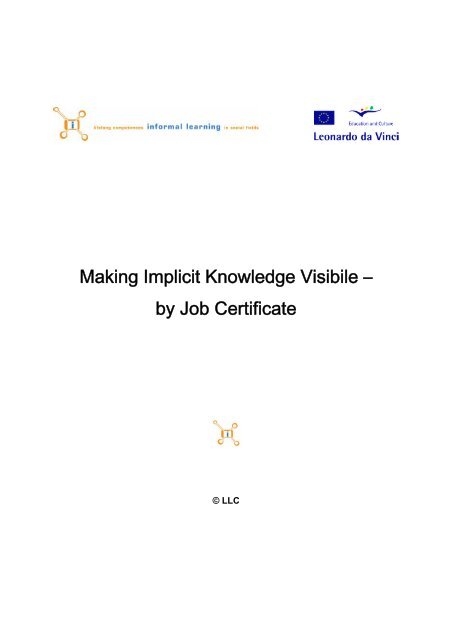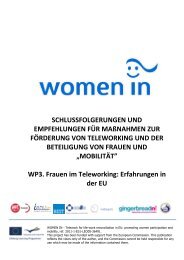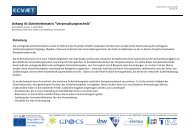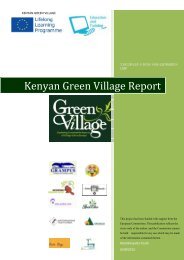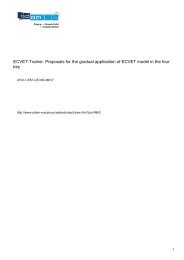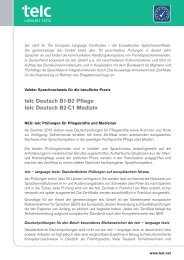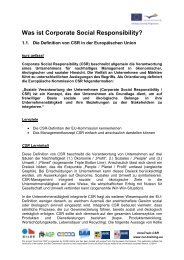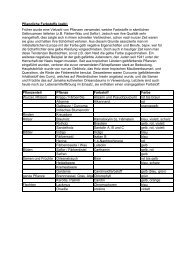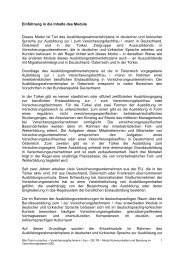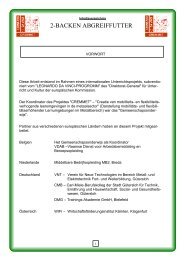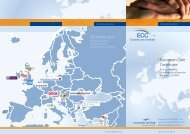2008 01 Arbeitszeugnis - Englisch.pdf - ADAM - Leonardo da Vinci ...
2008 01 Arbeitszeugnis - Englisch.pdf - ADAM - Leonardo da Vinci ...
2008 01 Arbeitszeugnis - Englisch.pdf - ADAM - Leonardo da Vinci ...
You also want an ePaper? Increase the reach of your titles
YUMPU automatically turns print PDFs into web optimized ePapers that Google loves.
Making Implicit Knowledge Visibile –<br />
by Job Certificate<br />
© LLC
Making Implicit Knowledge Visibile –<br />
by Job Certificate<br />
Task:<br />
It is more and more important that key- and core competences get access in job certifications. The product Job-Skills-<br />
Certification is developed as prototype regarding to the European Curriculum Vitae. The EU CV is available since February<br />
2002 and is asking for knowledge and know-how of the applicant. The Job-Skills-Certification is a complement for the EU CV to<br />
be able to point out developed competences in a more expressive way.<br />
Circularing terms:<br />
Knowledge: When we are talking about knowledge the sum of all reproducible knowledge here is meant, which is<br />
created in an organised and structured context (education and training) and which gets legitimated by a<br />
certification.<br />
Experience: (often repeated) made perceptions regarding to familiar or new situations. An experience is an<br />
perception on the one hand meaning a realized occasion on the other hand the sum of all perceptions, sensations<br />
and cognitive processes of examinations with the environment and from that made acquaintance, acquirements<br />
and skills. So we mean all that which is staying in mind/memory, which is recallable and usable<br />
(www.wikipedia.org)<br />
Competence: The ability to apply acquaintances, knowledge (know what) and know-how and skills both in familiar<br />
as in changing situations. There are five different levels of competences.<br />
Know-how: The practical knowledge or expertise.<br />
Learning in practice: the project partnership changed the term „informal learning“ into the term „learning in<br />
practice“ for a more practicable and understan<strong>da</strong>ble use.<br />
Introduction:<br />
The current and individual knowledge and competences are changing continuously<br />
especially if the knowledge is used in different situations and in different contexts. Tasks<br />
which seem to be similar often have to be solved in different ways to catch the goals.
Knowledge depends on an ongoing process; the same knowledge can be more or less<br />
efficient in different situations. Knowledge has to be a<strong>da</strong>pted depending on context. The<br />
general requirements – e.g. more productivity, more quality, lower costs – force to a<strong>da</strong>pt your<br />
knowledge regarding to context and needs so fast as possible to be up to the goals and<br />
stan<strong>da</strong>rds. Or simply said: we have to learn!<br />
New competences arise -<br />
the circulation<br />
knowledge<br />
Knowledge-new<br />
familiar<br />
situation<br />
new<br />
situation<br />
action<br />
action-new<br />
a<strong>da</strong>ption<br />
formal<br />
informal<br />
“by learning is meant relatively sustainable changes in an individuals competence as a result<br />
by the individuals interaction with the environment.” (1996 “Rutin och reflection, in Livslångt<br />
lärande, eds Ellström P-E, Gustavsson, B., Larsson, S. Studentlitteratur. Lund pp147ff)<br />
Ellström goes further and connect learning to individuals action and competence. The<br />
substance of learning is then a change in the individual competence. Competence is defined<br />
as “an individual’s potential capacity to act in relation to a certain task, situation in life or in<br />
work.”<br />
Formal knowledge is organised by others and is focused to certain goals and<br />
methods.
Phenomenon<br />
competence<br />
Learning process competence<br />
stimulate and support processes<br />
Take care of diversity (children – adults)<br />
System / context competence<br />
e.g. Kindergarten – Schule - …<br />
On the contrary new approaches, new points of views and qualities are needed in the<br />
informal area, in real life: The ability for self-organisation, holistic approach (holistic<br />
recognition of clients’ situation from the client’s point of view). These conditions are changing<br />
continuously, too with new parameters of stan<strong>da</strong>rds and legal and organisational targets,<br />
tasks, worth, expectations, needs etc. see: chapter “context”). In that area where these<br />
components meet one another is the area where competences develop or have to get<br />
developed. If the area of activity is well equipped to meet these contexts more development<br />
will run (see chapter “arenas and platforms”). In general each work place offers a lot of<br />
impulses to stimulate learning.<br />
Knowledge/<br />
Competence<br />
Know-how Act e.g.<br />
dialogue,<br />
reflexion<br />
Process<br />
Below the possibilities are presented to change job certificate into a meaningful tool for the<br />
documentation of informal competences.
1.The (formal) job certificate - basic<br />
Usually a job certification is used for information about<br />
+ who (which employee)<br />
+ employment from when until when<br />
+ in which formal function<br />
+ in which field of responsibility<br />
+ in which company<br />
These kind of certificate don’t inform about made experiences, know-how and the<br />
employee’s competences or inform only on a low level.<br />
2.Job certificate – LLC-Level<br />
The goal of this kind of job certificate is to attest and evidence the employee and his/her new<br />
leader about the (formal) knowledge, about the (informal) made experiences, know-how,<br />
about the competences which have been made during the vocational run. In addition to the<br />
formal job certification this certification on LLC level should consist of:<br />
A. Basic: Occupational qualifications and skills – formal as well as informal skills (this is<br />
essential to be able to associate later developed knowledge and skills)<br />
B. New acquired non-formal qualities e.g. acquaintances and competences (attestable<br />
by other certifications and vali<strong>da</strong>tions)<br />
C. New acquaintances and skills, abilities and competences made by „learning in<br />
practice“<br />
A guide to grasp informal knowledge and competences from „learning in<br />
practice“:<br />
Indication 1: Context<br />
+ In which context (situation, tasks etc.) has the employee been activ and which skills have<br />
resulted?<br />
+ By which external influences the employee’s effect was affected and which special<br />
acquaintances were won?<br />
+ E.g. which legal conditions have had an effect on the activity of the employee<br />
(special knowledge, experiences)?
+ Which organisational design (vision, mission, structures and culture of the<br />
company) effected on the employee and has stimulated to which individual<br />
developments?<br />
+ Which competences resulted on which individual approaches and expectations?<br />
Indication 2: Tasks<br />
+ Which experiences and which competences have been resulting on typical and<br />
extraordinary tasks and situations of a) client and b) employee?<br />
+ Which every<strong>da</strong>y tasks and responsibilities the employee has been put in charge of and<br />
which experiences and competences has been resulting?<br />
+ In which topics the employee felt responsible on a very high level and how this competence<br />
was expressed?<br />
Indication 3: Learning Processes / Empowerment<br />
+ Which experiences and competences the employee has developed from learning<br />
processes in mutuality, e.g.<br />
- when establishing a relationship,<br />
- when creating orientation and man<strong>da</strong>te,<br />
- when setting up activity plans and realisation,<br />
- when evaluating<br />
with clients, with colleagues, in team, with leaders?<br />
+ In which projects and in which special tasks the employee has been put in charge of?<br />
Which experiences and which acquaintances the employee has won? In which way these<br />
competences have been expressed?<br />
+ Which publications (written, vocal, internal, external) the employee has done?<br />
+ With which special tasks the employee has been put in charge of?<br />
Indication 4: „Being a multiplicator in every<strong>da</strong>y situations“<br />
+ Which special experiences have been made on case studies / conferences?<br />
+ Which experiences have been made when consulting clients and colleagues (in an active<br />
and passive way)?<br />
+ Which experiences haven been made when setting up a habilitation plan (in quality and<br />
quantity) and when evaluating?<br />
+ Which experiences have been made in projects and tests?<br />
+ Which special experiences have been aroused in <strong>da</strong>ily cooperation with other professions?
Indication 5: Special tasks<br />
+ Which specific tasks and works the employee has effected and on which competences<br />
based these results?<br />
Indication 6: Experience and know-how carrier<br />
+ In which topics and challenges the employee has shown his experience and competence?<br />
+ With which experiences and which know-how the employee has been a medium and<br />
carrier of knowledge in the team, in the organisation, regional, international and in which<br />
functions he was charge of?<br />
+ For which topics the employee has been in demand of the colleagues, clients and other<br />
external persons?<br />
+ For which topics the employee has been in touch and exchange with professionals of other<br />
organisations?<br />
+ For which publications the employee has been in charge of?<br />
Indication 7: Competences which support „learning in practice“ (see chapter “competences”<br />
in assessment-method-set)<br />
5 different levels of competence<br />
Acquaintance<br />
level<br />
Introduction<br />
level<br />
Base level Advanced level Expert level<br />
1 – Acquaintance<br />
Level<br />
To have an awareness of…<br />
2 – Introduction Level To have a limited amount of knowledge but enough to know which<br />
professional has more knowledge.<br />
3 – Base Level To know and understand to the degree that knowledge can be
used in practice. To be able to reflect on one’s own actions and<br />
describe these actions in a comprehensible manner<br />
4 - Advanced Level To be able to convey one’s knowledge to others objectively. To be<br />
able to reflect together with others in order to re-evaluate one’s<br />
own knowledge and actions. To be able to review new knowledge<br />
and research critically. To be able to evaluate one’s own<br />
knowledge and compare them to other peoples knowledge<br />
5 – Expert Level<br />
To be able to initiate the development of new knowledge through<br />
constructive reflexion<br />
To have a deep and well grounded knowledge that covers the<br />
whole area of competence. To be able to develop methods and to<br />
a degree new theories as well as to contribute to the development<br />
of knowledge for others<br />
Developing a job certificate – LLC level:<br />
Existing dilemmas:<br />
a) The partnership’s experiences is leaders mostly trust in formal information of a job<br />
certificate. If there are pointed out information about experience, know-how of the applicant<br />
the correctness of information often gets in doubt. We don’t take this as a valued expression<br />
but more as an understan<strong>da</strong>ble question, if the applicant would really be able to bring in his<br />
skills and know-how in the new working environment (context with situation and culture).<br />
A job certificate being set up step by step could clear doubts. A comprehensible approach<br />
enables to orientate in a faster and easier way. Of course to give correct information is in the<br />
responsibility of a leader. If the leader will confirm his made information with his signature<br />
this will be an important contribution to attest made perceptions and to win formality.
. Job certificates get not reliable if doubts arise regarding the information content. This may<br />
happen if colleagues get praised espacially to initiate a change. LLC faces this challenge<br />
with the specific and formally naming of name, address, telephone, mail of the leader who is<br />
responsible.<br />
c. LLC has experienced that colleagues have been shocked when seeing a detailed and<br />
extensive job certificate. First we mention the responsibility to use a job certificate is in<br />
charge of the employee. Of course a wished formal and short job certification can be handed<br />
out any time. The advantage for the leader to hand out a job certificate with LLC level is to<br />
know which knowledge, which experiences and which know-how the organisation, the<br />
division, the team, the colleagues will lose.<br />
d. In German companies there is also a practice running, to let the employee write down the<br />
job certificate himself. In the process of a job certification this is useful; but doing so only at<br />
the end of the employment this will lead to uncertainty and so authenticity will be missed.<br />
LLC’s solution is to develop a running job certificate step by step.<br />
Process of developing a job certificate – LLC level<br />
Organisations, divisions, teams, employees (and their clients) are in a learning and<br />
development process continuously. The individual development is influenced from a wide<br />
range of external and internal stimuli (see chapter “Essential components of informal<br />
learning”).<br />
The different contributions und interpretations of the partner organisation have lead to a<br />
model according this continuous change.<br />
A job certification is to set up in different steps.
Steps for job certification<br />
Jobcertification<br />
Job-<br />
Selfevaluation<br />
when when<br />
Self-<br />
started started<br />
Evaluation<br />
after after 6<br />
months months<br />
(employee +<br />
leader)<br />
Evaluation<br />
each each year year<br />
(appraisal<br />
interview)<br />
Current Current<br />
status status =<br />
Job Job<br />
certification<br />
if if changing<br />
Company 1<br />
We act on the assumption an applicant will bring in a job certification or no one, if he just has<br />
finished his education and has never been working.<br />
Step 1: A written self-evaluation of the applicant is demanded<br />
Step 2: After six months both the self-evaluation of the new colleague as well as an<br />
evaluation of the leader has to be done. Both valuations will be discussed, goals and steps<br />
get committed.<br />
Step 3: One time a year the same step will be done within the scope of the individual<br />
competence development plan. The result will be documented in a written way. This can be<br />
done parallel to the appraisal interview.<br />
Step 4: The current result is forming the final job certificate.<br />
Advantages:<br />
+ Both leaders and employees have a current status<br />
+ Steps of development get committed and realized in a mutual way<br />
+ If there are created competences they get pointed out (explicit) and will not be forgotten<br />
+ The needs of development get visible (explicit) and concrete steps will be realized<br />
+ A better planning and managing of employment<br />
+ The leader is in charge of the employee’s development.<br />
+ The leader is able to care of the employee’s development. General human resources<br />
departments often are too far-out. Those departments mostly only offer infrastructural<br />
support.<br />
Attachment: Completion for EUROPASS EU CV as an example for a job certificate
Attachment - LLC Job Skill Certification<br />
Completion for EUROPASS EU-CV<br />
The competence valuation will run in five competence levels<br />
Acquaintance Introduction Base level Advanced level Expert level<br />
level<br />
level<br />
1 – Acquaintance<br />
Level<br />
To have an awareness of…<br />
2 – Introduction Level To have a limited amount of knowledge but enough to know which<br />
professional has more knowledge.<br />
3 – Base Level To know and understand to the degree that knowledge can be<br />
used in practice. To be able to reflect on one’s own actions and<br />
describe these actions in a comprehensible manner<br />
4 - Advanced Level To be able to convey one’s knowledge to others objectively. To be<br />
able to reflect together with others in order to re-evaluate one’s<br />
own knowledge and actions. To be able to review new knowledge<br />
and research critically. To be able to evaluate one’s own<br />
knowledge and compare them to other peoples knowledge<br />
5 – Expert Level<br />
To be able to initiate the development of new knowledge through<br />
constructive reflexion<br />
To have a deep and well grounded knowledge that covers the<br />
whole area of competence. To be able to develop methods and to<br />
a degree new theories as well as to contribute to the development<br />
of knowledge for others
General acquantainces/knowledge:<br />
Basics<br />
Tasks, funktions<br />
for community<br />
creativ fields<br />
alternative<br />
methods<br />
spezial practical<br />
knowledge<br />
Acquaint.<br />
level<br />
introduction<br />
level<br />
Basic<br />
level<br />
Advanced<br />
level<br />
Expert<br />
level<br />
sport and<br />
leasure time<br />
General acquantainces/knowledge in services for people with disability<br />
Basic worth<br />
about human<br />
and disability<br />
Ethics<br />
Acquaint.<br />
level<br />
introduction<br />
level<br />
Basic<br />
level<br />
Advanced<br />
level<br />
Expert<br />
level<br />
pe<strong>da</strong>gogical<br />
priciples<br />
conventions,<br />
laws, regulations<br />
vision, mission
Process- and methods - skills – in general<br />
Acquaint.<br />
level<br />
introduction<br />
level<br />
Basic<br />
level<br />
Advanced<br />
level<br />
Expert<br />
level<br />
Recognise a<br />
problem<br />
Formulate the<br />
target<br />
Knowledge<br />
about methods<br />
How to select<br />
methods<br />
How to use<br />
methods<br />
Evaluation<br />
Documentation<br />
Reflexion<br />
Learng<br />
processes and<br />
empowerment<br />
Learning and<br />
competencedevelopment<br />
work in and with<br />
a team<br />
teamdevelopment<br />
Know-how<br />
Disability/<br />
diagnosis<br />
Sever motor<br />
disorder<br />
mental<br />
retardition<br />
neuropsychiatric<br />
al disorder<br />
acquired brain<br />
<strong>da</strong>mage<br />
combined svere<br />
motor and<br />
communication<br />
impairment<br />
Acquaint.<br />
level<br />
introductio<br />
n level<br />
Basic<br />
level<br />
Advanced<br />
level<br />
Expert<br />
level
Added<br />
impairments +<br />
special topics<br />
impaired vision<br />
impaired hearing<br />
speech and<br />
language<br />
disorder<br />
oral motor<br />
disorder/oraldysfunction<br />
dysfagia<br />
epilepsy<br />
psychological<br />
symptoms<br />
behavioural<br />
disorders<br />
nutrition<br />
pain<br />
psychosomatic<br />
neurology<br />
neuropsychology<br />
system theory<br />
entnography and<br />
religion –<br />
function<br />
impairment<br />
human<br />
development in a<br />
life cycle<br />
different aspects<br />
in development<br />
development of<br />
motor skill<br />
development of<br />
cognition<br />
learning<br />
development of<br />
perception<br />
development of<br />
communication<br />
emotional<br />
development<br />
social<br />
development<br />
psychosexual<br />
development<br />
development of<br />
identity<br />
disability and<br />
sexuality<br />
disability and<br />
ageing<br />
communication<br />
alternative<br />
supplementary<br />
communication<br />
conversation<br />
methodology<br />
crisis and grief
pe<strong>da</strong>gogical way<br />
of working/<br />
methods<br />
gui<strong>da</strong>nce<br />
internal<br />
supervision /<br />
Balint group<br />
consultation<br />
education,<br />
teaching,<br />
instruction<br />
theory of<br />
science, science<br />
methodology<br />
Wegleiter<br />
Special competences<br />
speciel<br />
seminars,<br />
trainings,<br />
educations –<br />
please list up<br />
paste<br />
Acquaint.<br />
level<br />
introduction<br />
level<br />
Basic<br />
level<br />
Advanced<br />
level<br />
Expert<br />
level<br />
Extra:<br />
Please list up if you have been a referent, lecturer etc.:<br />
………………………………………………………………………………………………………………………<br />
………………………………………………………………………………………………………………….……<br />
………………………………………………………………………………………………………………………..
Social skills and competences<br />
Self-evaluation<br />
-- ++<br />
Social engagement<br />
Optimism<br />
Ability to dialogue<br />
Ability to energize, to set stimuli<br />
Ability to communicate<br />
Ability to a<strong>da</strong>pt myself<br />
Ability to take personal responsibility<br />
Ability to work in a team<br />
Ability to be creative<br />
Ability to resolve conflicts<br />
Ability to solve problems<br />
Ability to cooperate<br />
Ability to be open-minded for changes<br />
Willingness to create<br />
Ability to deal with relationships<br />
Ability to authenticity<br />
Ability to reflect<br />
LLC, August 2007<br />
Lifelong Competences – Informal Learning in Social Fields<br />
October 2004 – November 2007<br />
Community action programme on vocational training<br />
Procedure B<br />
Second phase: 2000 –2006<br />
PILOT PROJECTS, LANGUAGE COMPETENCES, TRANSNATIONAL NETWORKS<br />
AGREEMENT n° 2004-A/04/B/F/PP-158.112<br />
Main authors:<br />
Per Skoglund, Lena Björnhage, Tone Engen, Venerand Erkinger, Lars-åke Larsson, Marie-Louise Ljungblad, Gun B. Nilsson,<br />
Christina Westerberg, Eva Sandstedt, Eva Knobloch


